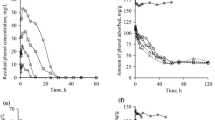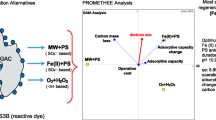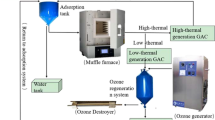Abstract
The efficacy of Fenton reagent and hydrogen peroxide for the regeneration of saturated granular activated carbon with biological effluent of dyeing wastewater was compared based on adsorption–oxidation recycle experiments. The catalytic performance of granular activated carbon and the necessity of ferrous ions were discussed. It was demonstrated that Fenton reagent or H2O2 was effective in destroying toxic organics and removing organic pollutants from the surface of granular activated carbon. The regeneration efficiency of granular activated carbon was about 50 % with Fenton reagent or H2O2 evaluated by chemical oxygen demand removals in adsorption. However, the synergic catalysis of granular activated carbon and ferrous ions enhanced the mineralization of organic pollutants and resulted in a higher regeneration efficiency of granular activated carbon evaluated by total organic carbon removals in adsorption compared with H2O2 alone.








Similar content being viewed by others
References
Harrelkas F, Azizi A, Yaacoubi A, Benhammou A, Pons MN (2009) Treatment of textile dye effluents using coagulation–flocculation coupled with membrane processes or adsorption on powdered activated carbon. Desalination 235:330–339
Lee JW, Choi SP, Thiruvenkatachari R, Shim WG, Moon H (2006) Evaluation of the performance of adsorption and coagulation processes for the maximum removal of reactive dyes. Dyes Pigments 69:196–203
Chakraborty S, De S, Basu JK, Dasgupta S (2005) Treatment of a textile effluent: application of a combination method involving and nanofiltration. Desalination 174:73–85
Ahmad AL, Puasa SW (2007) Reactive dyes decolourization from an aqueous solution by combined coagulation/micellar-enhanced ultrafiltration process. Chem Eng J 132:257–265
Choo KH, Choi SJ, Hwang ED (2007) Effect of coagulant types on textile wastewater reclamation in a combined coagulation/ultrafiltration system. Desalination 202:262–270
Solmaz SKA, Birgül A, Üstün GE, Tasdemir Y (2006) Colour and COD removal from textile effluent by coagulation and advanced oxidation processes. Color Technol 122:102–109
Barreto-Damas S, Iborra-Clar MI, Bes-Piá A, Alcaina-Miranda MI, Mendoza-Roca JA, Iborra-Clar A (2005) Study of preozonation influence on the physical–chemical treatment of textile wastewater. Desalination 182:267–274
Wang L, Yao YY, Zhang ZH, Sun LJ, Lu WY, Chen WX, Chen HX (2014) Activated carbon fibers as an excellent partner of Fenton catalyst for dyes decolorization by combination of adsorption and oxidation. Chem Eng J 251:348–354
Liu RP, Liu HJ, Zhao X, Qu JH, Zhang R (2010) Treatment of dye wastewater with permanganate oxidation and in situ formed manganese dioxides adsorption: cation blue as model pollutant. J Hazard Mater 176:926–931
Ribeiro RS, Fathy NA, Attia AA, Silva AMT, Faria JL, Gomes HT (2012) Activated carbon xerogels for the removal of the anionic azo dyes orange II and chromotrope 2R by adsorption and catalytic wet peroxide oxidation. Chem Eng J 195–196:112–121
Quintanilla A, Casas JA, Rodriguez JJ (2010) Hydrogen peroxide-promoted-CWAO of phenol with activated carbon. Appl Catal B: Environ 93:339–345
Rey A, Zazo JA, Casas JA, Bahamonde A, Rodriguez JJ (2011) Influence of the structural and surface characteristics of activated carbon on the catalytic decomposition of hydrogen peroxide. Appl Catal A General 402:146–155
Huang HH, Lu MC, Chen JN, Lee CT (2003) Catalytic decomposition of hydrogen peroxide and 4-chlorophenol in the presence of modified activated carbon. Chemosphere 51:935–943
Lucking F, Koser H, Jank M, Ritter A (1998) Iron powder, graphite and activated carbon as catalysts for the oxidation of 4-chlorophenol with hydrogen peroxide in aqueous solutions. Water Res 32(9):2607–2614
Fontecha-Cámara MA, Álvarez-Merino MA, Carrasco-Marín F, López-Ramón MV, Moreno-Castilla C (2011) Heterogeneous and homogeneous Fenton processes using activated carbon for the removal of the herbicide amitrole from water. Appl Catal B: Environ 101:425–430
Wang LG (2013) Removal of disperse red dye by bamboo-based activated carbon: optimisation, kinetics and equilibrium. Environ Sci Pollut Res 20:4635–4646
Owamah HI (2014) Biosorptive removal of Pb(II) and Cu(II) from wastewater using activated carbon from cassava peels. J Mater Cycles Waste Manag 16:347–358
Zhang L, Liu JY, Wan LH, Zhou Q, Wang XZ (2012) Batch and fixed-bed column performance of phosphate adsorption by lanthanum-doped activated carbon fiber. Water Air Soil Pollut 223:5893–5902
Nath K, Bhakhar MS (2011) Microbial regeneration of spent activated carbon dispersed with organic contaminants: mechanism, efficiency, and kinetic models. Environ Sci Pollut Res 18:534–546
Berenguer R, Marco-Lozar JP, Quijada C, Cazorla-Amoros D, Morallon E (2009) Effect of the electrochemical treatments on the surface chemistry of activated carbon. Carbon 47:1018–1027
Ania CO, Menéndez JA, Parra JB, Pis JJ (2004) Microwave-induced regeneration of activated carbons polluted with phenol: a comparison with conventional thermal regeneration. Carbon 42:1383–1387
Berenguer R, Marco-Lozar JP, Quijada C, Cazorla-Amoros D, Morallon E (2010) Electrochemical regeneration and porosity recovery of phenol-saturated granular activated carbon in an alkaline medium. Carbon 48:2734–2745
Huling SG, Jones PK, Ela WP, Arnold RG (2005) Fenton-driven chemical regeneration of MTBE-spent GAC. Water Res 39:2145–2153
Huling SG, Jones PK, Lee TR (2007) Iron optimization for Fenton-driven oxidation of MTBE-spent granular activated carbon. Environ Sci Technol 41:4090–4096
Huling SG, Kan E, Wingo C (2009) Fenton-driven regeneration of MTBE-spent granular activated carbon-effects of particle size and iron amendment procedures. Appl Catal B: Environ 89:651–657
Huling SG, Ko S, Park S, Kan E (2011) Persulfate oxidation regeneration of MTBE and chloroform-spent granular activated carbon. J Hazard Mater 192:1484–1490
Huling SG, Kan E, Wingo C, Park S (2012) Fenton-driven regeneration of MTBE spent granular activated carbon—a pilot study. J Hazard Mater 205–206:55–62
Horng RS, Tseng IC (2008) Regeneration of granular activated carbon saturated with acetone and isopropyl alcohol via a recirculation process under H2O2/UV oxidation. J Hazard Mater 154:366–372
Hutson A, Ko S, Huling SG (2012) Persulfate oxidation regeneration of granular activated carbon: reversible impacts on sorption behavior. Chemosphere 89:1218–1223
Liang C, Lin YT, Shin WH (2009) Persulfate regeneration of trichloroethylene spent activated carbon. J Hazard Mater 168:187–192
Liang C, Lin YT, Shih WH (2009) Treatment of trichloroethylene by adsorption and persulfate oxidation in batch studies. Ind Eng Chem Res 48:8373–8380
Liang C, Guo YY, Chien YC, Wu YJ (2010) Oxidative degradation of MTBE by pyrite activated persulfate: proposed reaction pathways. Ind Eng Chem Res 49:8858–8864
Okawa K, Suzuki K, Takeshita T, Nakano K (2007) Regeneration of granular activated carbon with adsorbed trichloroethylene using wet peroxide oxidation. Water Res 41:1045–1051
Kan E, Huling SG (2009) Effects of temperature and acidic pre-treatment on Fenton-driven oxidation of MTBE-spent granular activated carbon. Environ Sci Technol 43:1493–1499
Singh KP, Mohan D, Sinha S, Tondon GS, Gosh D (2003) Colour removal from wastewater using low cost and activated carbon derived from agricultural waste material. Ind Eng Chem Res 42:1965–1976
Franz M, Arafat HA, Pinto NG (2000) Effect of chemical surface heterogeneity on the adsorption mechanisms of dissolved aromatics on activated carbon. Carbon 38:1807–1819
Li L, Quinlivan PA, Knappe DRU (2002) Effects of activated carbon surface chemistry and pore structure on the adsorption of organic contaminants from aqueous solution. Carbon 40:2085–2100
Furlan FR, Melo da Silva LG, Morgado AF, Ulson de Souza AA, Ulson de Souza SMAG (2010) Removal of reactive dyes from aqueous solutions using combined coagulation/flocculation and adsorption on activated carbon. Resour Conserv Recy 54:283–290
Papic S, Koprivanac N, Bozic AL, Metes A (2004) Removal of some reactive dyes from synthetic wastewater by combined Al(III) coagulation/carbon adsorption process. Dyes Pigments 62:291–298
Fang GD, Liu C, Gao JA, Zhou DM (2014) New Insights into the mechanism of the catalytic decomposition of hydrogen peroxide by activated carbon: implications for degradation of diethyl phthalate. Ind Eng Chem Res 53:19925–19933
Yao YY, Wang L, Sun LJ, Zhu S, Huang ZF, Mao YJ, Lu WY, Chen WX (2013) Efficient removal of dyes using heterogeneous Fenton catalysts based on activated carbon fibers with enhanced activity. Chem Eng Sci 101:424–431
Wang L, Yao YY, Sun LJ, Mao YJ, Lu WY, Huang SQ, Chen WX (2014) Rapid removal of dyes under visible irradiation over activated carbon fiber supported Fe(III)-citrate at neutral pH. Sep Purif Technol 122:449–455
Toledo LC, Bernades Silva AC, Augusti R, Montero Lago R (2003) Application of Fenton’s reagent to regenerate activated carbon saturated with organochloro compounds. Chemosphere 50:1049–1057
Anfruns A, Garcıa-Suarez EJ, Montes-Moran MA, Gonzalez-Olmos R, Martin MJ (2014) New insights into the influence of activated carbon surface oxygen groups on H2O2 decomposition and oxidation of pre-adsorbed volatile organic compounds. Carbon 77:89–98
Ruhl AS, Altmann J, Zietzschmann F, Meinel F, Sperlich A, Jekel M (2014) Integrating micro-pollutant removal by powdered activated carbon into deep bed filtration. Water Air Soil Pollut 225:1877–1883
Acknowledgments
The financial support from the National Science Foundation of China under contract number 21277023 is greatly acknowledged.
Author information
Authors and Affiliations
Corresponding authors
Rights and permissions
About this article
Cite this article
Chen, Q., Liu, H., Yang, Z. et al. Regeneration performance of spent granular activated carbon for tertiary treatment of dyeing wastewater by Fenton reagent and hydrogen peroxide. J Mater Cycles Waste Manag 19, 256–264 (2017). https://doi.org/10.1007/s10163-015-0410-y
Received:
Accepted:
Published:
Issue Date:
DOI: https://doi.org/10.1007/s10163-015-0410-y




